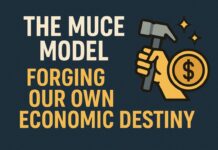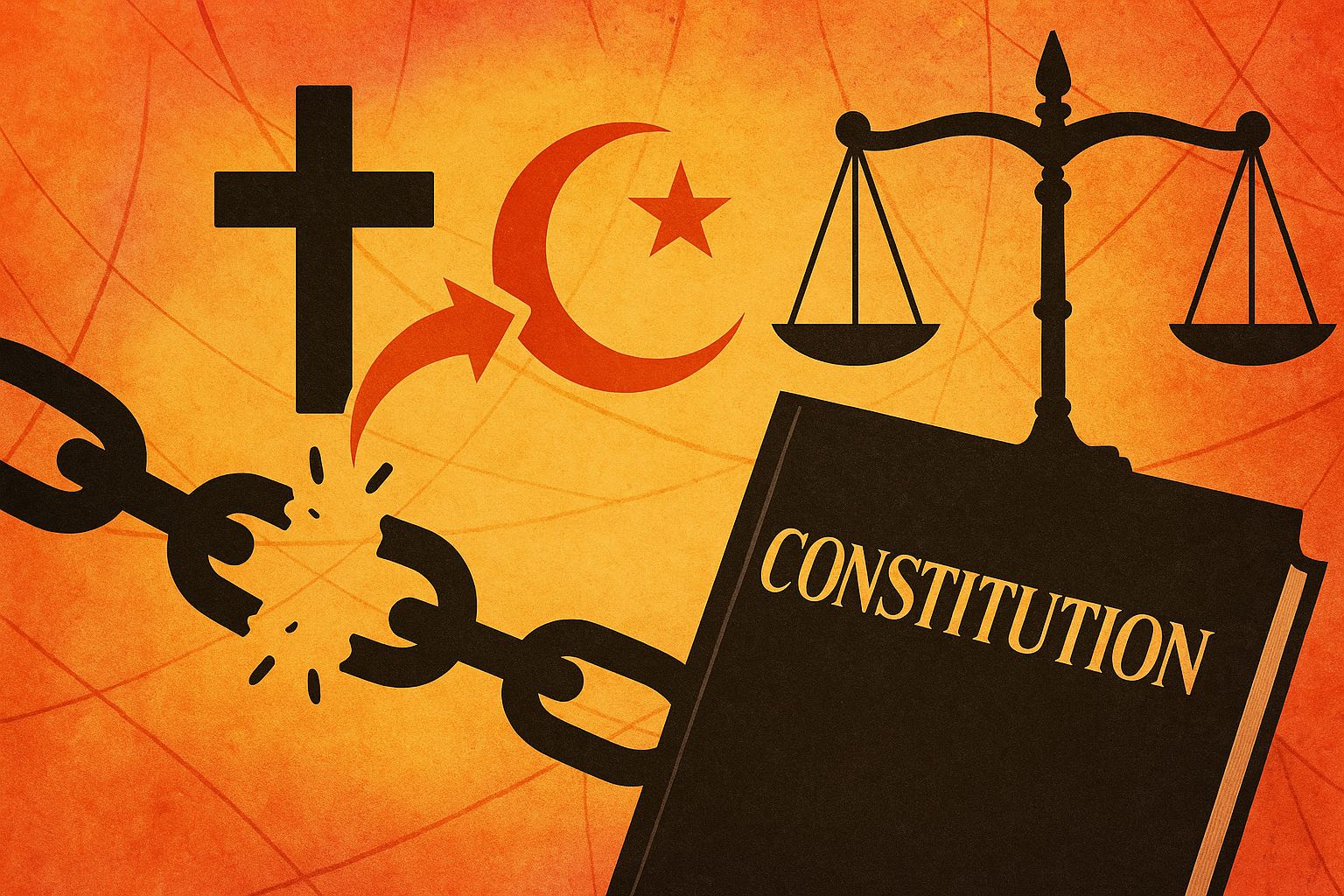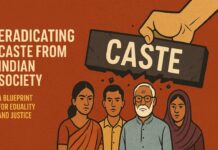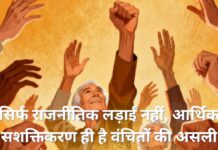Blueprints for Upliftment: Operationalizing Ambedkar Today
Dr. B.R. Ambedkar’s visionary philosophy of social justice and human dignity continues to inspire transformative community development efforts across India. His foundational principle of “Educate, Agitate, Organize” has evolved beyond mere slogan to become a practical framework for systematic community upliftment. Contemporary implementation of Ambedkarian ideals demonstrates that his revolutionary ideas can be translated into replicable, sustainable community models that address the complex challenges of modern India while remaining rooted in democratic values and inclusive development.
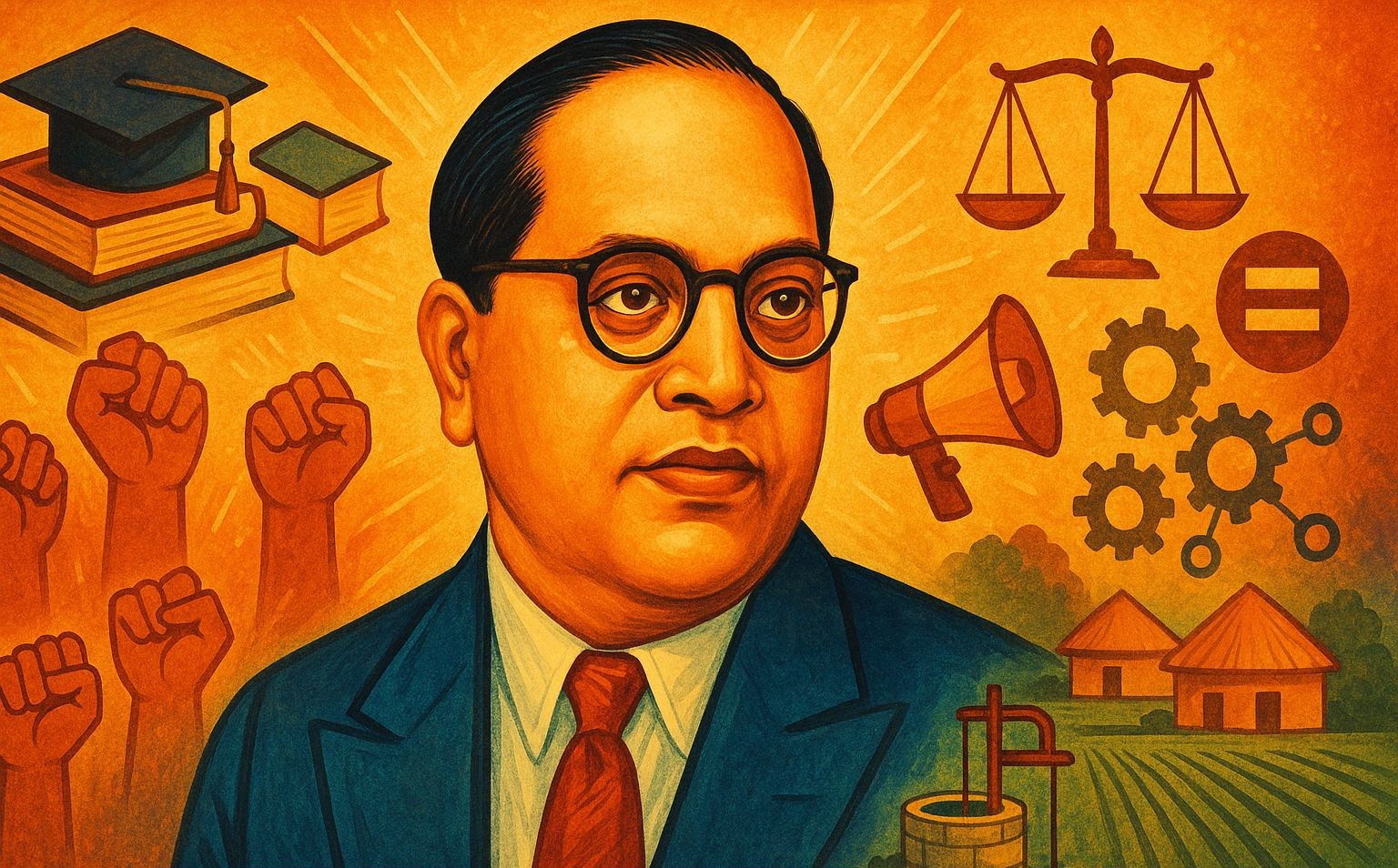
The Philosophical Foundation for Community Action
Ambedkar’s approach to social transformation was inherently systematic and community-focused. His belief that “education is what makes a person fearless, teaches him the lesson of unity, makes him aware of his rights and inspires him to struggle for his rights” forms the cornerstone of contemporary community development models. Unlike individualistic approaches to social change, Ambedkar emphasized collective empowerment through institutional mechanisms that could sustain long-term transformation. [1][2]
The core principles underlying Ambedkarian community models center on social democracy rather than merely political democracy. As Ambedkar envisioned, true democracy must encompass “a way of life which recognizes liberty, equality and fraternity as the principles of life”. This philosophical foundation creates the framework for community models that address not just economic poverty but also social exclusion, cultural marginalization, and political powerlessness. [3]
Contemporary interpretations of Ambedkar’s philosophy emphasize pragmatic problem-solving approaches influenced by John Dewey’s democratic experimentalism. This pragmatic orientation enables community development practitioners to adapt Ambedkarian principles to diverse local contexts while maintaining fidelity to the core values of justice, equality, and human dignity. [4]
The Triangular Framework: Education, Agitation, Organization
The timeless relevance of Ambedkar’s “Educate, Agitate, Organize” framework lies in its comprehensive approach to social change. Education serves as the foundation for critical consciousness, enabling communities to understand the structural causes of their marginalization. Agitation represents the organized resistance to oppressive systems and the active assertion of rights and dignity. Organization provides the institutional mechanisms for sustaining change and building collective power. [5]
Modern community development models operationalize this triangular framework through integrated programming that simultaneously addresses educational advancement, advocacy training, and institutional capacity building. Successful implementations recognize that all three elements must work in tandem – education without organization remains ineffective, while agitation without proper grounding in education can become counterproductive.
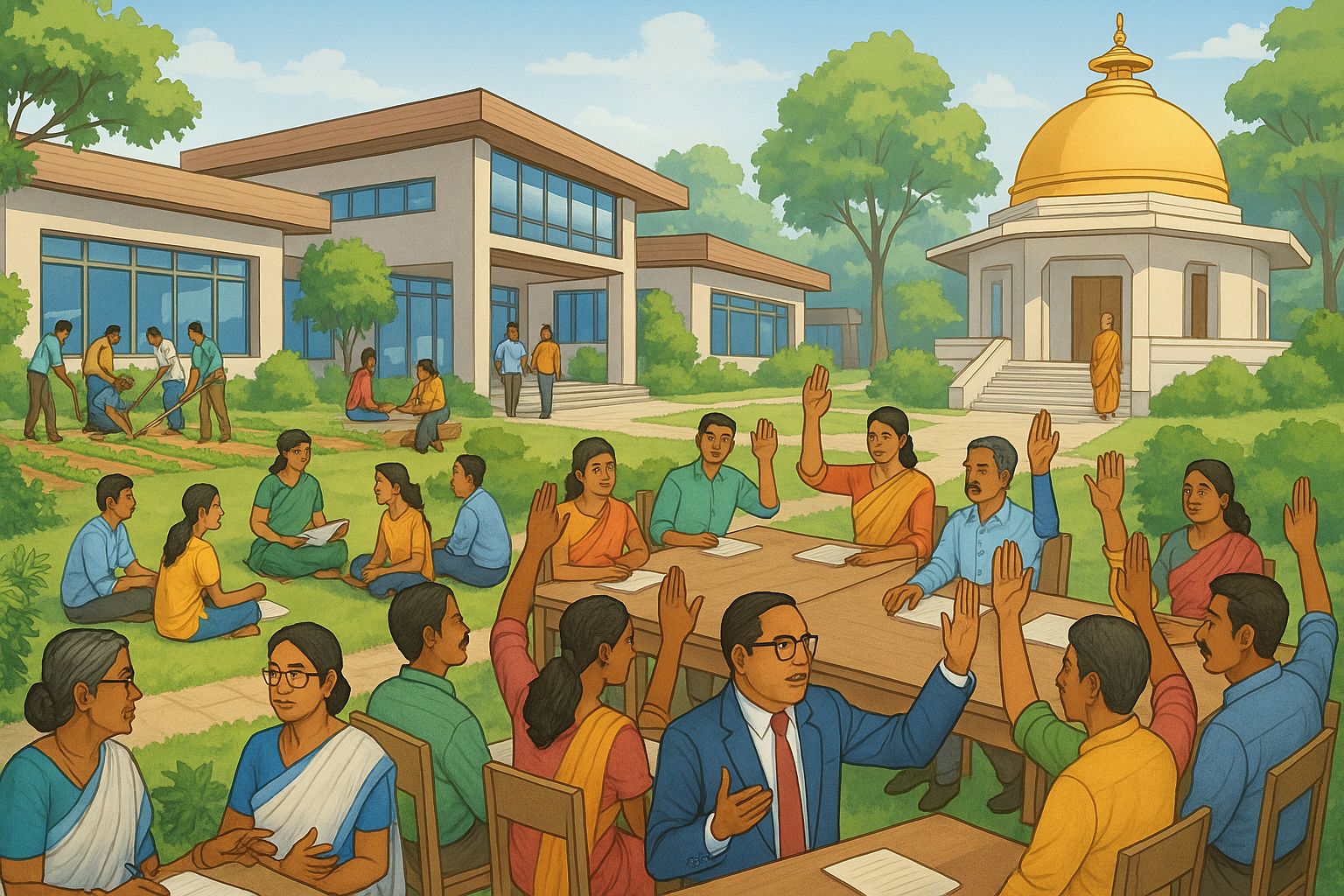
Contemporary Models of Ambedkarian Community Development
Educational Institutions as Catalysts for Social Change
The People’s Education Society, founded by Ambedkar in 1945, continues to serve as the most successful model for Ambedkarian educational philosophy. Operating twelve colleges across Maharashtra and running schools, polytechnics, and hostels, the Society demonstrates how educational institutions can function as comprehensive community development centers. The Society’s “inclusive approach embedded with the support system for the poor and needy students has been instrumental in practically implementing the policy of ‘Education to All'”. [2][6]
The replication potential of this model lies in its multi-dimensional approach. Rather than simply providing formal education, People’s Education Society institutions function as community anchors that address housing (through hostels), skill development (through polytechnics), and leadership formation (through democratic participation in institutional governance). Contemporary replications should incorporate modern elements such as digital literacy, entrepreneurship training, and environmental sustainability while maintaining the core commitment to serving marginalized communities.
Modern iterations of this model are emerging through organizations like the Navayan Buddhist Society, which has established the Ambedkar Knowledge Center and Prabuddha Cultural Center in John Peta village. This two-project approach demonstrates scalability – the Knowledge Center provides “quality education and skills training to underprivileged Dalit communities through its modern facilities, such as a computer lab, modern library, reading room, and conference room”, while the Cultural Center creates space for community celebrations, interfaith marriages, and cultural programming that builds social cohesion. [7][8]
Community-Based Organizations and Grassroots Mobilization
The most successful contemporary applications of Ambedkarian principles operate through community-based organizations (CBOs) that implement democratic participation while addressing concrete needs. The case study of Rashtra Chetan (RC) groups in Bihar, supported by Dr. Bhim Rao Ambedkar Kalyan Evam Vikas Sansthan, illustrates how Ambedkarian principles translate into effective grassroots organizing. [9]
These RC groups demonstrate the power of structured meetings with well-defined agendas that gradually build collective strength and the ability to address issues of deprivation and unjust treatment of Dalit communities. The model’s effectiveness lies in its systematic approach: women meet fortnightly to discuss specific issues, develop collective responses, and take coordinated action. This creates a sustainable mechanism for ongoing community problem-solving while building leadership capacity. [9]
The RC model addresses both immediate needs and systemic issues. Groups focus on “accessing basic services so that the children get better education” while simultaneously engaging in “protest at the village level” and participating “in the DAM’s district and state-level campaigns for the rights of Dalits”. This dual approach – local service delivery combined with broader political engagement – exemplifies successful operationalization of Ambedkar’s philosophy. [9]
Collective Farming and Economic Empowerment Models
Punjab’s Zila Prodhoga Sangharsh Committee (ZPSC) has developed innovative applications of Ambedkarian economic principles through collective farming initiatives in 55 villages. This model operationalizes Ambedkar’s vision of collective agriculture as a means of breaking economic dependence and building community self-reliance. [10]
The collective farming approach addresses multiple dimensions of empowerment simultaneously. Economic benefits flow from pooled resources and shared risks, while social benefits emerge from the necessity of democratic decision-making and conflict resolution. As one participant noted: “We are no longer afraid and can confront the big farmers collectively”. This confidence building represents a crucial psychological dimension of community empowerment that extends beyond economic gains. [10]
The replication potential of collective farming models depends on supportive policy environments and access to land. However, the organizational principles – democratic decision-making, resource pooling, collective risk management, and gradual expansion of economic activities – can be adapted to other economic sectors including small-scale manufacturing, service cooperatives, and marketing associations.
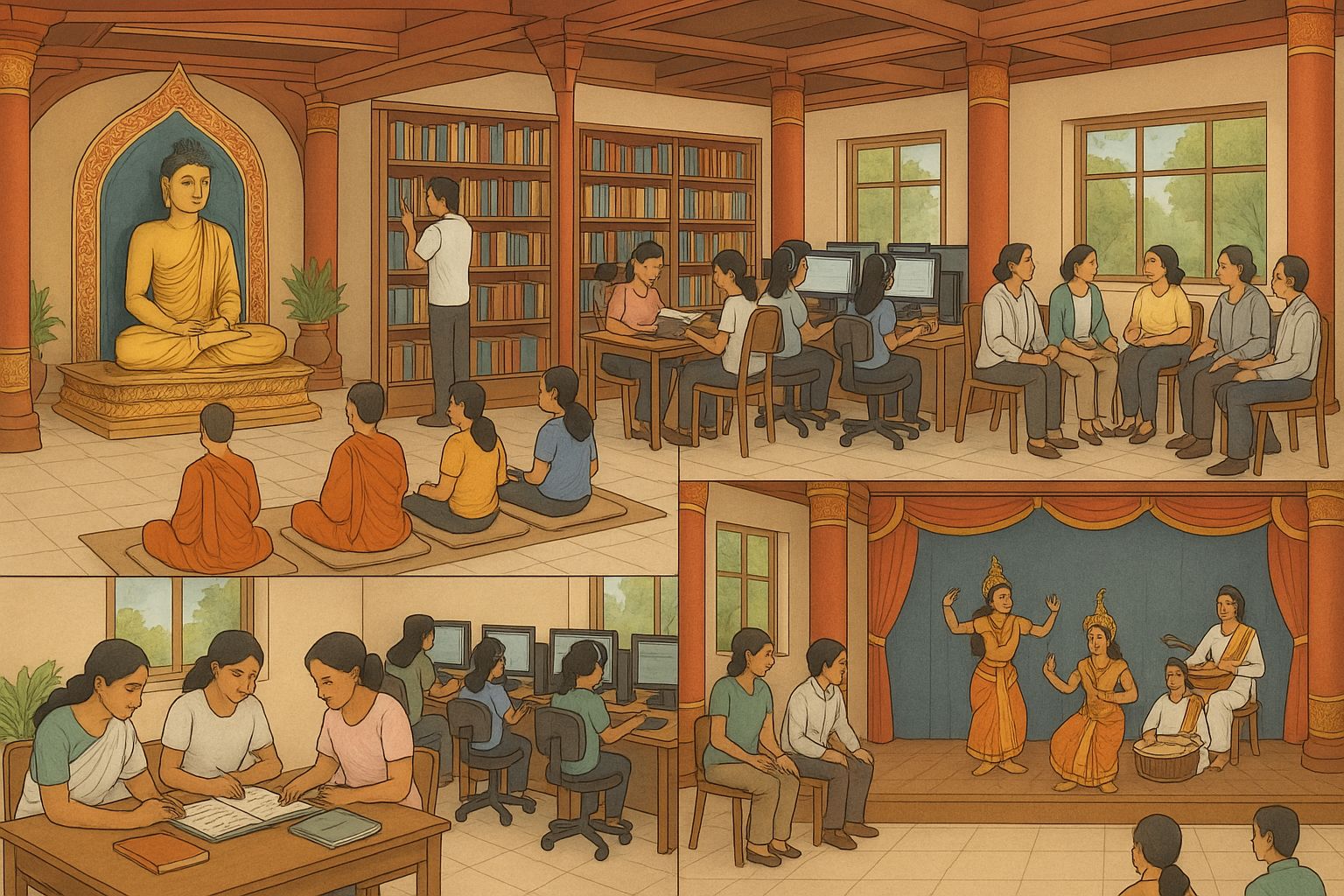
Buddhist Community Development and Cultural Transformation
Viharas as Knowledge Centers
Contemporary Navayana Buddhist communities have developed innovative approaches to community development centered around Buddha Viharas as centers of knowledge rather than mere places of worship. This model operationalizes Ambedkar’s vision of Buddhism as a rational, socially engaged spiritual practice that contributes to community upliftment. [11]
The transformation of community halls into libraries and educational spaces demonstrates practical innovation in resource utilization. As documented in Nagpur’s northern communities, “Buddha Viharas provide spaces with a strong philosophical foundation that makes Navayana Buddhists think rationally about every aspect of life”. The integration of meditation halls with computer labs, libraries, and meeting spaces creates multifunctional community centers that serve diverse needs. [11]
The challenge and opportunity in replicating this model lies in community engagement and overcoming traditional attitudes. The case studies reveal that “converting the community hall into a community library was not an easy task because we had to fight against the beliefs and perspectives of our people”. Successful implementation requires sustained advocacy, demonstration of benefits, and gradual community buy-in through programming that meets immediate needs while building long-term capacity.[11]
Cultural Programming for Social Cohesion
The Prabuddha Cultural Center model demonstrates how cultural programming can support broader community development goals. By hosting “free modern intercaste and interfaith marriages” alongside educational programming, these centers address both immediate community needs and longer-term social transformation objectives.[8]
This approach recognizes that sustainable social change requires cultural as well as economic and political transformation. The integration of celebration, education, and social services within single institutions creates natural opportunities for community building across traditional divisions while reinforcing values of equality and inclusion.
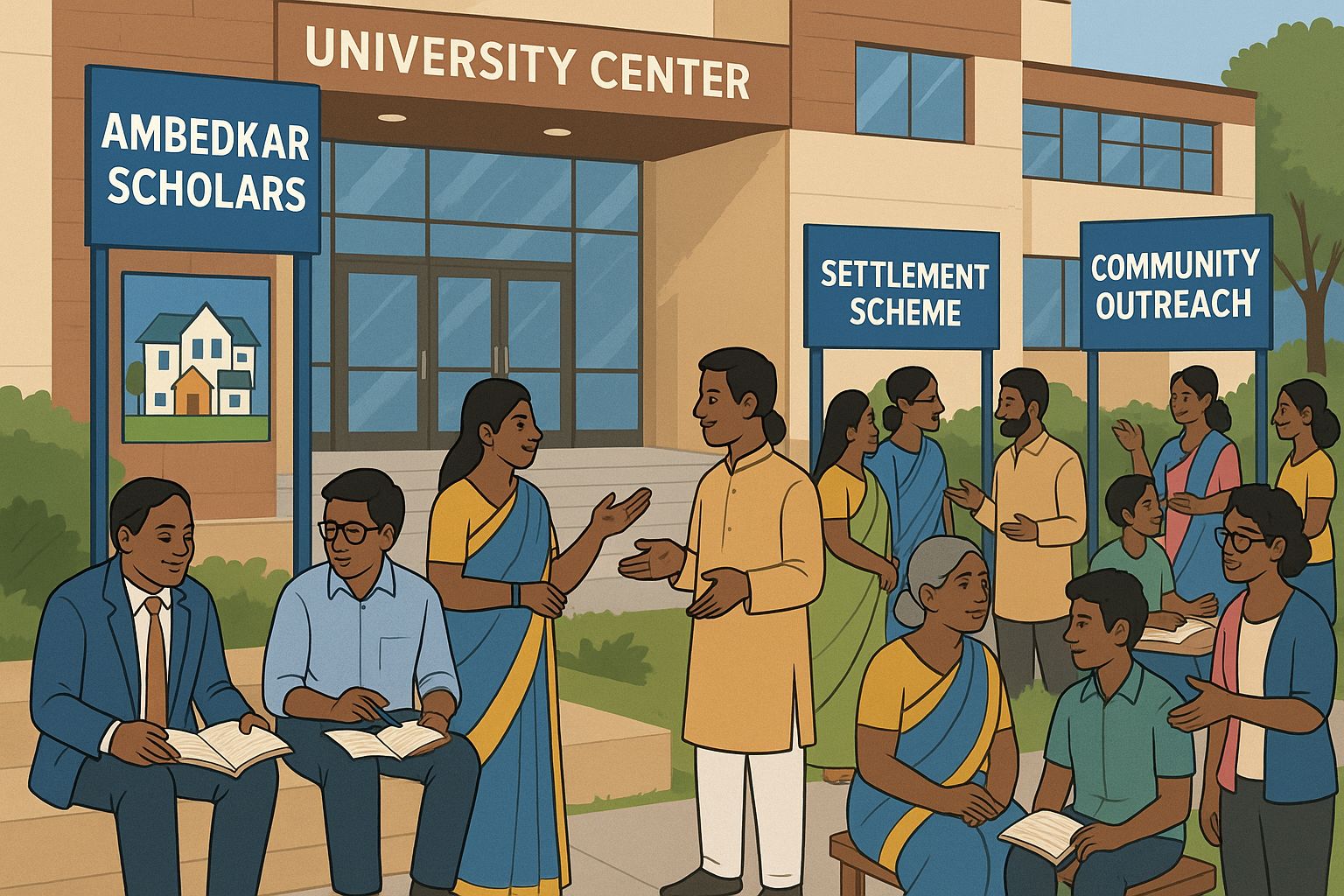
Institutional Models for Scaling Impact
Government-Supported Schemes and Policy Integration
The Ambedkar Settlement Development Scheme in Kerala illustrates how government initiatives can incorporate Ambedkarian principles into official policy frameworks. The scheme’s emphasis on “family/settlement based micro plan interventions” using “participatory rural appraisal tools” reflects core Ambedkarian commitments to democratic participation and community-driven development.[12]
The scheme’s comprehensive approach – addressing infrastructure, economic activities, education, health, and cultural facilities within single settlements – operationalizes Ambedkar’s understanding that sustainable upliftment requires simultaneous attention to multiple dimensions of human development. The convergence approach, integrating “schemes of the Scheduled Tribes Development Department and also the scheme of Local Self Governments, LIFE Mission, MGNREGS, Health, Education, Kudumbashree, Integrated Child Development Scheme”, demonstrates how Ambedkarian principles can inform large-scale policy implementation.[12]
Academic and Research Institutions
The establishment of Dr. Ambedkar Centres of Excellence in 31 Central Universities represents systematic institutionalization of Ambedkarian scholarship and community engagement. These centers combine research, education, and community service, providing free coaching for Scheduled Caste students while conducting research on marginalized communities. [13]
This model demonstrates how higher education institutions can function as community development resources rather than isolated academic entities. The integration of research, teaching, and service creates sustainable institutional mechanisms for ongoing community engagement while building the intellectual foundation for continued social transformation.
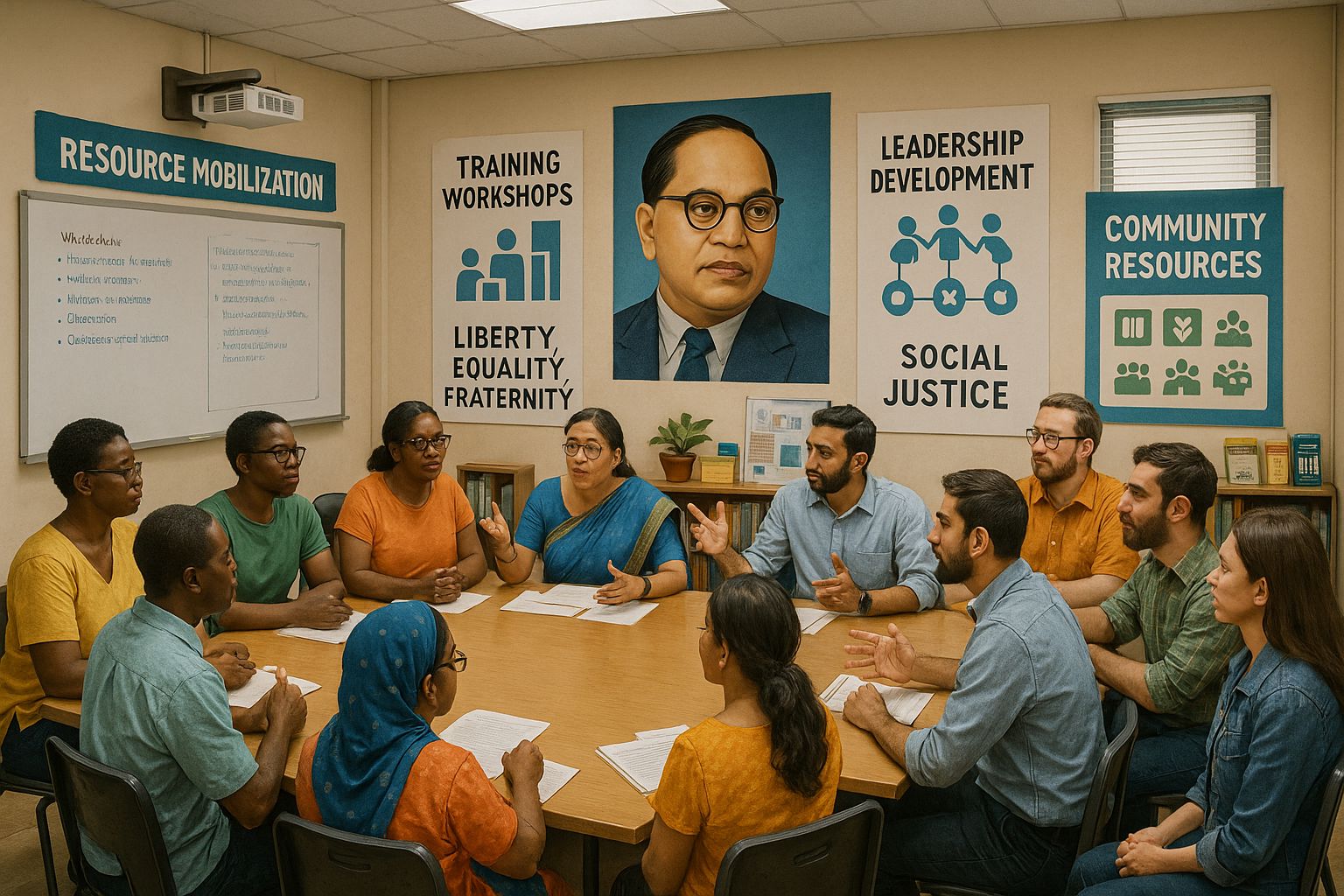
Operational Frameworks for Implementation
Community Organization Methodology
Successful Ambedkarian community development relies on systematic application of community organization principles that align with democratic values and participatory development approaches. The most effective models incorporate Ross’s principle that “discontent with existing conditions in the community must initiate and/or nourish development of the association”, ensuring that organizing efforts emerge from genuine community needs rather than external impositions.[14]
The inter-group approach proves particularly relevant for diverse communities that include “people of different backgrounds, occupations, castes, religions and political affiliations”. Effective models begin by identifying smaller groups for initial engagement, then develop linkages across groups for addressing larger-scale challenges. This approach respects existing social networks while gradually building broader coalitions.[15]
Democratic functioning remains central to all successful implementations. The principle recognizes that “there is a tendency among common people to remain passive and allow others to take decisions for them”. Ambedkarian models explicitly combat this tendency through structured processes that require active participation while building leadership capacity at multiple levels.[15]
Resource Mobilization and Sustainability
Sustainable community development models require careful attention to resource mobilization strategies that balance external support with community ownership. The most successful examples, such as the People’s Education Society, demonstrate how initial external funding can catalyze community investment and long-term self-sustainability.
The indigenous resource mobilization approach proves crucial for sustainability. This includes both material resources – land, buildings, volunteer time – and human resources – local knowledge, leadership capacity, and social networks. Models that effectively combine external technical assistance with indigenous resource mobilization create more sustainable and culturally appropriate interventions.
Contemporary models also demonstrate the importance of flexible organizational structures that can adapt to changing circumstances while maintaining core commitments. The ability to expand programming, modify service delivery, and respond to emerging opportunities requires organizational systems that balance structure with adaptability.
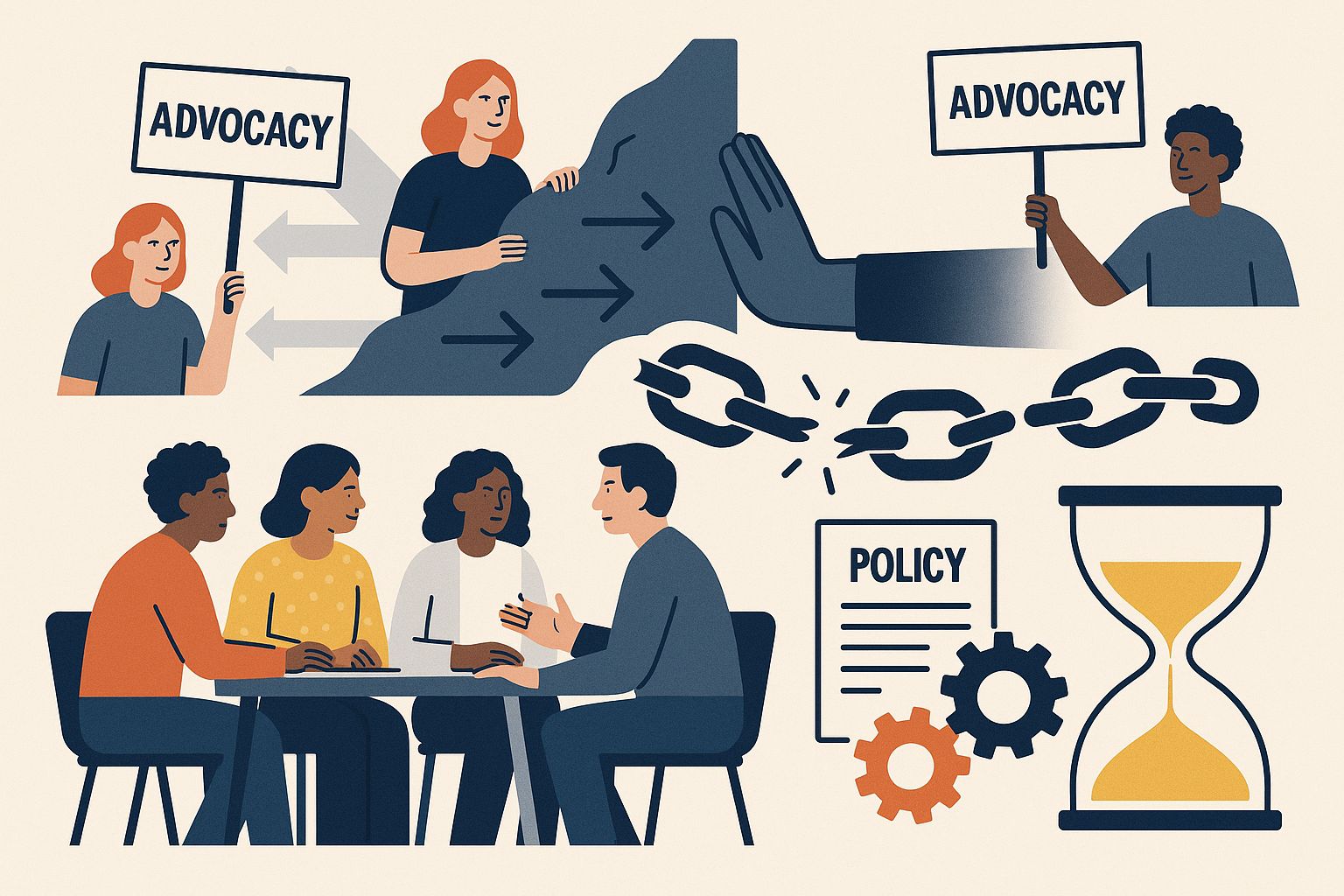
Challenges and Adaptive Strategies
Addressing Resistance and Building Alliances
Implementation of Ambedkarian community development models faces predictable challenges from existing power structures and traditional social hierarchies. Case studies consistently document resistance from dominant castes and weak implementation due to political opposition. Successful models develop explicit strategies for managing resistance while building alliances with sympathetic individuals and organizations.[16]
The experience of community library development in Buddha Viharas illustrates both challenges and solutions. Initial resistance from community management committees required sustained advocacy, demonstration of benefits, and gradual expansion of programming to build support. The key insight is that cultural change requires both persistence and strategic patience – immediate confrontation often proves counterproductive compared to gradual demonstration of alternative possibilities.
Building alliances with sympathetic actors – progressive political leaders, supportive NGOs, enlightened individuals from all communities – provides crucial resources for overcoming resistance. The most successful models create broad-based coalitions that make opposition more difficult while providing protection for vulnerable community members.
Integration with Existing Systems
Contemporary community development must navigate complex relationships with government programs, NGO initiatives, and private sector involvement. Successful Ambedkarian models demonstrate the possibility of principled engagement with existing systems while maintaining independent organizational capacity.
The RC groups in Bihar illustrate effective integration strategies. By aligning with government schemes like the “DAM-advocated demand to provide 10 decimal of land per family as per the recommendations of the Bandhopadhyay commission”, these groups leverage official resources while maintaining independent organizing capacity. This approach avoids both co-optation and marginalization.[9]
Similarly, the People’s Education Society’s relationship with university systems demonstrates how community-controlled institutions can engage formally accredited educational frameworks while maintaining distinctive educational philosophies and community orientations.
Future Directions and Scalability
Technology Integration and Modern Applications
Contemporary implementations of Ambedkarian principles must address digital divides and technological opportunities that didn’t exist in Ambedkar’s time. The Ambedkar Knowledge Centers that include “computer lab, modern library, reading room, and conference room” point toward integration strategies that maintain core values while embracing beneficial technologies.[7]
Digital platforms create new possibilities for “agitation” through social media organizing and online awareness campaigns. Similarly, “education” can be enhanced through online resources, distance learning, and digital skill development. “Organization” benefits from digital communication tools, online coordination systems, and electronic resource mobilization.
However, technology integration must avoid creating new forms of exclusion. Models that successfully incorporate technology do so while maintaining commitment to serving the most marginalized communities and ensuring that digital tools enhance rather than replace human relationships and community solidarity.
Policy Advocacy and Systemic Change
Individual community development projects, however successful, cannot address structural inequalities without complementary policy advocacy and systemic change efforts. The most impactful Ambedkarian models combine direct community service with advocacy for supportive policy environments.
The evolution from individual Dr. Ambedkar Chairs to systematic Centres of Excellence illustrates how successful local models can inform policy development and institutional expansion. Similarly, the integration of community-based approaches into government schemes like MGNREGA demonstrates how grassroots innovations can influence large-scale policy implementation.
Future scaling efforts should prioritize policy advocacy that creates enabling environments for community-controlled development while building networks of organizations that can share resources, exchange experiences, and coordinate advocacy efforts.
Building Movement Infrastructure
The long-term success of Ambedkarian community development depends on building movement infrastructure that can sustain organizing efforts across multiple generations and changing political circumstances. This requires attention to leadership development, institutional sustainability, and ideological continuity.
Leadership development must balance respect for experienced organizers with systematic preparation of younger generations. The most effective models create explicit mentorship programs, leadership training curricula, and succession planning processes that ensure continuity while enabling adaptation to changing circumstances.
Institutional sustainability requires diversified resource bases, organizational systems that outlast individual leaders, and adaptive capacity that enables response to new challenges and opportunities. Contemporary models demonstrate various approaches – fee-for-service programming, endowment building, government contracting, and membership dues – that can be combined strategically.
Ideological continuity ensures that practical organizing efforts remain grounded in Ambedkarian values of justice, equality, and human dignity. This requires ongoing education, reflection, and dialogue about core principles and their contemporary applications.
Conclusion
The operationalization of Ambedkar’s vision through replicable community models demonstrates that transformative social change remains possible through systematic, principled organizing that addresses immediate needs while building long-term capacity for justice and equality. From the People’s Education Society’s educational institutions to contemporary Buddhist community centers, from collective farming initiatives to government-supported settlement development schemes, successful implementations share common characteristics: democratic participation, comprehensive programming, resource mobilization that balances external support with community ownership, and strategic patience in building sustainable change.
The blueprint for contemporary Ambedkarian community development emerges clearly from these diverse examples. Effective models combine education, agitation, and organization through institutional frameworks that provide concrete services while building collective power. They address multiple dimensions of human development simultaneously – economic, social, cultural, and political – while maintaining clear commitment to justice and equality for the most marginalized communities.
The challenge for future implementations lies not in the absence of proven models but in adapting successful approaches to diverse local contexts while maintaining fidelity to core principles. The abundance of contemporary examples demonstrates that Ambedkar’s vision remains not only relevant but essential for addressing persistent inequalities and building the inclusive democracy that remains India’s unrealized promise.
As communities across India continue to struggle with the legacies of historical oppression and contemporary challenges of globalization, technological change, and environmental degradation, Ambedkarian community development models offer proven pathways toward collective empowerment and sustainable transformation. The task ahead is scaling and adapting these approaches while building the movement infrastructure necessary for long-term systemic change. The blueprints exist; the challenge lies in implementation with the same courage, persistence, and strategic vision that Ambedkar himself demonstrated throughout his remarkable life.
- https://www.multisubjectjournal.com/article/410/6-4-6-399.pdf
- https://drambedkarcollegeoflaw.com/Peoples-Education-Society
- https://www.mea.gov.in/Images/attach/amb/Volume_10.pdf
- https://www.drishtiias.com/daily-updates/daily-news-analysis/philosophical-perspectives-of-dr-br-ambedkar
- https://iasgoogle.com/news/dr-ambedkar-s-clarion-call-quot-educate-agitate-and-organize-quot-strategizes-the-dalit-movement-towards-achieving-civil-liberty-discuss-upsc-cse-mains-2023-political-science-and-international-relatio
- https://peopleseducationsociety.in
- https://navayan.org/navayan-buddhist-society/
- https://navayan.org/prabuddha-cultural-center/
- https://samarthan.org/admin/img/resources/Case studies of CBOs – samarthan (1).pdf
- https://scroll.in/article/1073623/how-village-cooperative-societies-are-mobilising-dalit-groups-to-maintain-and-protect-the-commons
- https://www.roundtableindia.co.in/role-of-community-libraries-for-youth-and-community-development/
- https://www.stdd.kerala.gov.in/index.php/ambedkar-settlement
- https://ambedkarfoundation.nic.in/dace.html
- https://www.facultyadda.com/2024/08/princip-of-community-org-sw.html?m=1
- https://egyankosh.ac.in/bitstream/123456789/59016/1/Unit3.pdf
- https://www.journalofpoliticalscience.com/uploads/archives/7-3-20-914.pdf
- https://www.theajhssr.com/vol-7-iss-5/THEAJHSSR_I0705079086018.pdf
- https://ymerdigital.com/uploads/YMER220416.pdf
- https://www.csirs.org.in/uploads/paper_pdf/dr-ambedkar-and-rural-development-in-present-day-scenario.pdf
- https://peoplesdemocracy.in/2016/0417_pd/contemporary-relevance-ambedkars-thought
- https://www.hurights.or.jp/archives/other_documents/section1/2009/03/the-ambedkar-principles.html
- https://www.historyjournal.net/article/460/7-7-11-949.pdf
- https://indiafoundation.in/articles-and-commentaries/revisiting-ambedkars-idea-of-nationalism/
- https://idsn.org/wp-content/uploads/user_folder/pdf/New_files/IDSN/Ambedkar_Principles_brochure.pdf
- https://theacademic.in/wp-content/uploads/2024/12/69.pdf
- https://drambedkarbooks.com/2015/04/13/dr-ambedkars-idea-of-india-and-his-legacy/
- https://pwonlyias.com/upsc-notes/dr-ambedkar-marginalized-communities/
- https://www.gapbodhitaru.org/res/articles/(509-514) AN OVERVIEW OF DR B R AMBEDKARS EDUCATIONAL PHILOSOPHY AND VISION.pdf
- https://thedaak.in/2025/04/14/ambedkar-in-contemporary-india/
- https://www.linkedin.com/pulse/dr-br-ambedkars-principles-relevance-modern-corporate-dr-giri-rzsec
- https://www.sciencedirect.com/science/article/pii/S2590291125006138
- https://theasianthinker.com/wp-content/uploads/2022/04/3.-NEW-The-Role-of-Dr.-Ambedkar-an-Inclusive-Social-Building.pdf
- https://aud.delhi.gov.in/philosophy-development-practice
- https://www.forwardpress.in/2017/04/communism-and-ambedkar-english/
- http://mu.ac.in/wp-content/uploads/2014/05/2015-History-of-Buddism-Dr-wagh-MA1.pdf
- https://ras.org.in/index.php?Article=b_r_ambedkar_on_caste_and_land_relations_in_india
- https://journals.library.brandeis.edu/index.php/caste/article/download/326/74/1335
- https://ccs.in/sites/default/files/2022-10/Dalit Self-Help Groups in Delhi.pdf
- https://journals.sagepub.com/doi/10.1177/0974354520130102
- https://en.wikipedia.org/wiki/Dalit_Buddhist_movement
- https://search.proquest.com/openview/66f6e92e4794b7f709eebf9d91056069/1?pq-origsite=gscholar&cbl=506331
- https://www.dpublication.com/wp-content/uploads/2019/05/hpsconf-13-123.pdf
- https://f4ff.global/assets/2025/06/5_Reimagining-Dalit-Feminist-Led-Caste-Equity-in-South-Asia-Pathways-for-Sustained-Funding-Movement-Building.pdf
- https://theambedkarianchronicle.in/caste-and-climate-change/caste-climate-and-justice-reimagining-environmentalism-in-india-through-ambedkarite-praxis/
- https://theambedkarianchronicle.in/archives/culture-for-social-and-economic-change-an-ambedkarite-buddhist-perspective
- https://www.bridgespan.org/insights/pathways-to-greater-social-mobility-for-india-dalit-and-adivasi-communities
- https://www.viirj.org/specialissues/2025/SP2502/58.pdf
- https://www.allsubjectjournal.com/assets/archives/2017/vol4issue2/4-2-47-359.pdf
- https://dalitsolidarity.org
- https://rjpn.org/ijcspub/papers/IJCSP12D1003.pdf
- https://www.roundtableindia.co.in/why-did-dr-ambedkar-choose-buddhism/
- http://www.dadasngo.com/aim.php
- https://drambedkarbooks.com/2015/07/08/8th-july-1945-in-dalit-history-peoples-education-society-was-formed-by-dr-babasaheb-ambedkar/
- https://ijcrt.org/papers/IJCRT1801600.pdf
- https://navayan.com/organizations.php?name=navayana
- https://velivada.com/2015/07/08/8th-july-1945-in-dalit-history-peoples-education-society-was-formed-by-dr-babasaheb-ambedkar/
- https://navayanabuddhist.org
- https://www.thefatherofmodernindia.com/2024/02/ambedkar-education-reforms.html
- https://ebooks.inflibnet.ac.in/socp13/chapter/babasaheb-ambedkar/
- https://en.wikipedia.org/wiki/Navayana
- https://give.do/discover/1AJY/dr-ambedkar-society-for-socio-economic-welfare-development/
- https://www.mea.gov.in/Images/CPV/Volume17_Part_II.pdf
- https://www.scribd.com/document/616934106/MODELS-OF-COMMUNITY-ORGANIZATION
- https://icertpublication.com/index.php/edu-mania/edumania-vol-1issue-2/impact-ofambedkars-teachings-on-community-development-as-shown-in-the-god-of-small-things-vol1issue2/
- https://www.calgary.ca/social-services/community-assessment/rothman-models.html
- https://philosophy.institute/dalit-philosophy/dr-ambedkar-vision-dalit-empowerment/
- https://icert.org.in/index.php/edu-mania/edumania-vol-1issue-2/impact-ofambedkars-teachings-on-community-development-as-shown-in-the-god-of-small-things-vol1issue2/
- https://www.sciedupress.com/journal/index.php/wjel/article/download/25737/15958
- https://www.slideshare.net/slideshow/rothmans-models-of-c/250858293
- https://joell.in/wp-content/uploads/2018/04/53-59-Dr.-P.-Venu-Gopal.pdf
- https://www.roundtableindia.co.in/dalit-scholars-take-anti-caste-movement-and-politics-from-academia-to-villages/
- https://aud.delhi.gov.in/community-engagement-and-services
- https://www.socialworkin.com/2021/08/8-principles-of-community-organization.html
- https://ijmer.in/pdf/volume1-issue2-2012/47-52.pdf
- https://aud.delhi.gov.in/engaging-families-and-communities
- https://en.wikipedia.org/wiki/Community_organization





